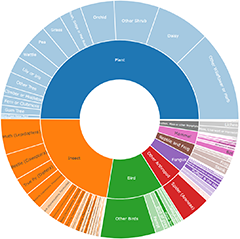Other fungi on wood
In this group you find those wood-inhabiting fungi that don’t fit into any of the previous categories.
Announcements
There are currently no announcements.
Discussion
Hejor1
wrote:
1 Oct 2025
@Heinol thank you, I think this counts as smooth then. It did have some imperfections but not consistently like those tiny pores look like.
zz flat polypore - white(ish)
Heinol
wrote:
1 Oct 2025
In fungi with such shelf-like fruiting bodies the underside may be pored, be packed with numerous ridges or with teeth or spines (in which the ends may be sharp or gently rounded) or be smooth. A smooth surface may have slight wrinkles or undulations or occasional warty bumps but you are still looking at what is essentially a smooth surface, continuous over minor rises – not at one packed with pores or protruding ridges, teeth or spines.
Some polypore species have very small pores, up to 10 per millimetre. To see such pores you may need to use a magnifying glass or hand lens. A close-up shot with a macro lens would also do the job – but even without that, if you enlarge a photo you my see the pores, depending on the quality of the photo. Here (https://www.neotropicalfungi.com/wp-content/uploads/2024/04/ANGE1885-Rigidoporus-microporus_risultato.jpg) is a photo of Rigidoporus microporus. In a description of this species you’d read that there are 6-9 pores per millimetre. One specimen has been turned to show the orange-brown underside and there are no obvious pores. If I enlarge this photo I still don’t see any pores but soon get into a pixelated image. Perhaps the original photo would show the pores – or perhaps the camera was not close enough to allow pores to show in any magnification of the original photo.
Sometimes a tiny-pored underside may show a slightly fuzzy look, since a smooth surface reflects light differently to a surface with numerous tiny pores. Your photo of the underside is a little blurry. If the edges had been sharp and the rest of the undersurface had been slightly fuzzy (but not obviously out of focus) I’d have suspected a pored surface.
Some polypore species have very small pores, up to 10 per millimetre. To see such pores you may need to use a magnifying glass or hand lens. A close-up shot with a macro lens would also do the job – but even without that, if you enlarge a photo you my see the pores, depending on the quality of the photo. Here (https://www.neotropicalfungi.com/wp-content/uploads/2024/04/ANGE1885-Rigidoporus-microporus_risultato.jpg) is a photo of Rigidoporus microporus. In a description of this species you’d read that there are 6-9 pores per millimetre. One specimen has been turned to show the orange-brown underside and there are no obvious pores. If I enlarge this photo I still don’t see any pores but soon get into a pixelated image. Perhaps the original photo would show the pores – or perhaps the camera was not close enough to allow pores to show in any magnification of the original photo.
Sometimes a tiny-pored underside may show a slightly fuzzy look, since a smooth surface reflects light differently to a surface with numerous tiny pores. Your photo of the underside is a little blurry. If the edges had been sharp and the rest of the undersurface had been slightly fuzzy (but not obviously out of focus) I’d have suspected a pored surface.
zz flat polypore - white(ish)
Hejor1
wrote:
29 Sep 2025
@Heinol how smooth does it have to be to be smooth? It didn't have obvious pores, but it wasn't completely smooth like the top of a mycena.
zz flat polypore - white(ish)
Heinol
wrote:
26 Sep 2025
Are you sure it's pored on the underside and not smooth? I can't tell for sure since the views of the underside are a little blurry.
zz flat polypore - white(ish)
Teresa
wrote:
20 Aug 2025
@Heino1 not one I recognise judging by the size of the the ants
Unverified Other non-black fungi
Top contributors
- trevorpreston 99
- Hejor1 40
- Heino 29
- KenT 24
- TimL 23
- CanberraFungiGroup 20
- Teresa 19
- Heino1 18
- mahargiani 11
- Paul4K 10
Top moderators
- Heino1 191
- Heinol 49
- Heino 40
- Teresa 20
- MichaelMulvaney 11
- Pam 8
- KenT 7
- CanberraFungiGroup 5
- Csteele4 5
- waltraud 1












